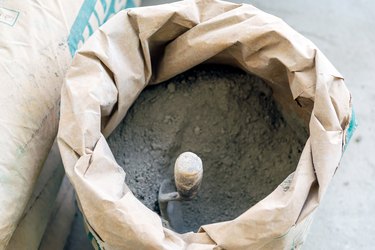Why wrestle with large, unwieldy natural rocks when you can make your own for outdoor and indoor projects. Mixing concrete to make aesthetically pleasing artificial rocks is as easy as following a recipe and watching the end result dry. You can make them big or small, roughly round or square and tall. With the right mix, you can create a structure of your own design that is durable, textured and totally DIY.

Video of the Day
Recipe Rules
A good recipe for artificial brick building uses the best mix for concrete. The cement is technically a cementitious mortar, which is a cement-based binding material for sticking building blocks and stones together. The main difference is gravel. Fake rock recipes call for mortar that is free of gravel and other large aggregates that can muddle with the mixture and final product. Gravel won't allow you to gain the right thickness for fake rocks that you are looking for. A good ratio is 3 parts of sand to 1 part of cement. This makes a strong product that is more easily malleable than concrete that contains larger chunks of gravel. Make sure to use sharp or brick sand rather than play or masonry sand that doesn't have the edges for the mix to hold and bond. Additives, such as fly ash, silica fume and acrylic polymer, will increase the density to create a fine fake rock that will last quite some time. Fiberglass adds strength and can minimize those annoying hairline cracks that tend to pop up in artificial rocks as they settle. It will also increase the tensile strength of the project when it is all put together.
Video of the Day
A basic guide is: 1 bag of Portland cement, 3 bags of sharp sand and 1 part aggregate or more to your liking.
Pour and Build
You can also add tint after you've mixed the mortar together. Adding tint at the end allows you to control the color of your project. But remember, it will more than likely dry paler than when you first mix it into the wet blend. Aside from the powdered materials, you'll need a few 5-gallon buckets for good measure, a power-driven paint mixer to get a good torque when you mix and gloves and eye gear for good measure. You can also create an organic mix using mud, grass and clay.
Once you mix your cement, it is then ready to pour into molds. You can use plastic buckets and cut them away after letting the cement cure for at least a day. There are a wide variety of molds online to make bricks, freeform shapes, faux fencing and more. Make sure to tamp the molds to release any air bubbles that could damage the stability. Let it cure for at least 24 hours and up to three days to ensure it is hardened and settled.